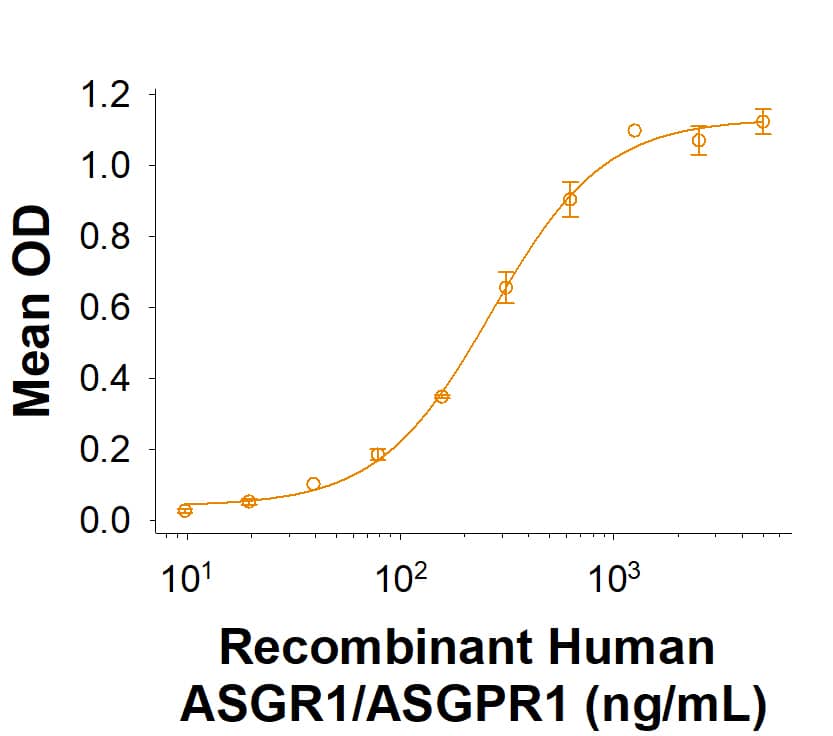Recombinant Human ASGR1/ASGPR1 Fc Chimera Protein, CF
R&D Systems, part of Bio-Techne | Catalog # 10255-AS

Key Product Details
Source
Accession #
Structure / Form
Conjugate
Applications
Product Specifications
Source
| MD | Human IgG1 (Pro100-Lys330) |
IEGR | Human ASGR1 (Asn63-Leu291) Accession # P07306-1 |
| N-terminus | C-terminus | ||
Purity
Endotoxin Level
N-terminal Sequence Analysis
Met
Predicted Molecular Mass
SDS-PAGE
Activity
Immobilized Recombinant Human ASGR1/ASGPR1 Fc Chimera (Catalog # 10255-AS) binds human plasma von Willebrand Factor with an ED50 of 0.15-0.9 μg/mL.
Scientific Data Images for Recombinant Human ASGR1/ASGPR1 Fc Chimera Protein, CF
Recombinant Human ASGR1/ASGPR1 Fc Chimera Protein Bioactivity
Immobilized Recombinant Human ASGR-1/ASGPR1 Fc Chimera (Catalog # 10255-AS) binds human plasma von Willebrand Factor with an ED50 of 150-900 ng/mL.Recombinant Human ASGR1/ASGPR1 Fc Chimera Protein SDS-PAGE
2 μg/lane of Recombinant Human ASGR1/ASGPR1 Fc Chimera (Catalog # 10255-AS) was resolved with SDS-PAGE under reducing (R) and non-reducing (NR) conditions and visualized by Coomassie® Blue staining, showing bands at 59-71 kDa and 120-140 kDa, respectively.Formulation, Preparation and Storage
10255-AS
| Formulation | Lyophilized from a 0.2 μm filtered solution in PBS. |
| Reconstitution | Reconstitute at 500 μg/mL in PBS. |
| Shipping | The product is shipped at ambient temperature. Upon receipt, store it immediately at the temperature recommended below. |
| Stability & Storage | Use a manual defrost freezer and avoid repeated freeze-thaw cycles.
|
Background: ASGR1/ASGPR1
The human asialoglycoprotein receptor (ASGPR) is an endocytic recycling receptor that belongs to the long-form subfamily of the C-type/Ca+2-dependent lectin family (1, 2, 3). It is a complex of two noncovalently-linked subunits, a major 46 kDa glycoprotein (ASGR1) and a minor 50 kDa glycoprotein (ASGR2). The major human ASGPR subunit, ASGR1 (also H1), is synthesized as a 291 amino acid (aa) type II transmembrane (TM) glycoprotein. It contains a 40 aa cytoplasmic region, a 21 aa TM segment, and a 230 aa extracellular domain (ECD) (4 - 6). The cytoplasmic region contains one palmitoylation site at Cys36 that is essential for ligand endocytosis and dissociation (7). The ECD contains two important structural regions. The first is a stalk region of 62 aa (aa 61-123) that contributes to noncovalent oligomerization. The second is a 118 aa, carbohydrate-binding, Ca+2-dependent C-type lectin domain (aa 161-278) that is stabilized by three Ca+2 ions (3, 8). Human ASGR1 ECD is 79% aa identical to mouse ASGR1 ECD. There are two minor (ASGR2) subunits that interact with ASGR1/H1 in a mutually exclusive manner to generate a functional ASGPR (9). They represent alternate splice forms of a type II TM protein. Termed H2b and H2c, H2b differs from H2c only by the presence of a 19 aa insert in its cytoplasmic region. This insert is significant because it allows serine phosphorylation of the cytoplasmic tail and provides for the majority of ASGPR ligand internalization (9). The stoichiometry of a functional ASGPR is unclear, but is suggested to be either a 2:2, 3:1 or 3:2 ratio of ASGR1/H1:ASGR2/H2 (9, 10, 11). ASGPR is found on hepatocytes and a subset of T cells (6, 12). ASGPR is reported to bind Gal (nonreducing), GalNAc, and sialic acid alpha2,6Gal and GalNAc (3, 13, 14, 15). This is generally within the context of triantennary or tetraantennary configurations (2). The sialic acid terminations are of particular interest because molecules with these motifs most likely represent the endogenous ligands for ASGPR (14).
References
- Stockert, R. J. (1995) Physiol. Rev. 75:591.
- Weigel, P.H. and J.H.N. Yik (2002) Biochim. Biophys. Acta 1572:341.
- Meier, M. et al. (2000) J. Mol. Biol. 300:857.
- Spiess, M. et al. (1985) J. Biol. Chem. 260:1979.
- Spiess, M. and H.F. Lodish (1986) Cell 44:177.
- Bischoff, J. et al. (1988) J. Cell Biol. 106:1067.
- Yik, J.H.N. et al. (2002) J. Biol. Chem. 277:40844.
- Monroe, R.S. and B.E. Huber (1994) Gene 148:237.
- Yik, J.H.N. et al. (2002) J. Biol. Chem. 277:23076.
- Bider, M.D. et al. (1996) J. Biol. Chem. 271:31996.
- Lodish, H. (1991) Trends Biochem. Sci. 16:374.
- Park, J-H. et al. (2006) Biotechnol. Lett. 28:1061.
- Westerlind, U. et al. (2004) Glyconj. J. 21:227.
- Park, E.I. et al. (2005) Proc. Natl. Acad. Sci. USA 102:17125.
- Park, E.I. et al. (2003) J. Biol. Chem. 278:4597.
Long Name
Alternate Names
Gene Symbol
UniProt
Additional ASGR1/ASGPR1 Products
Product Documents for Recombinant Human ASGR1/ASGPR1 Fc Chimera Protein, CF
Product Specific Notices for Recombinant Human ASGR1/ASGPR1 Fc Chimera Protein, CF
For research use only

